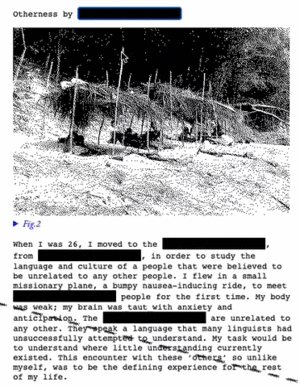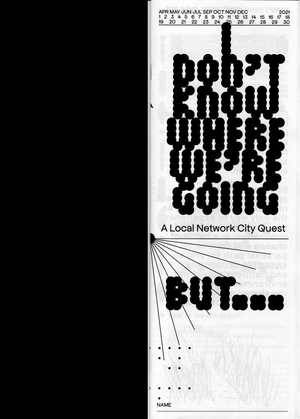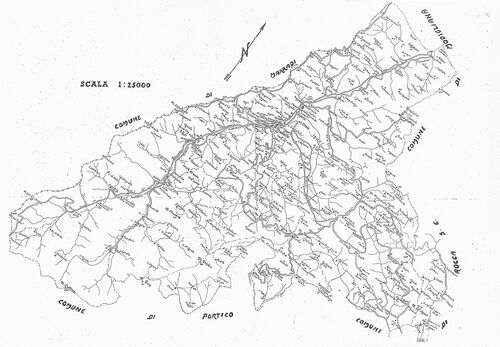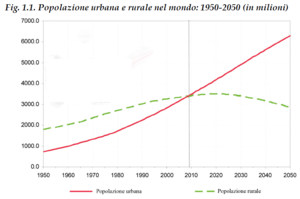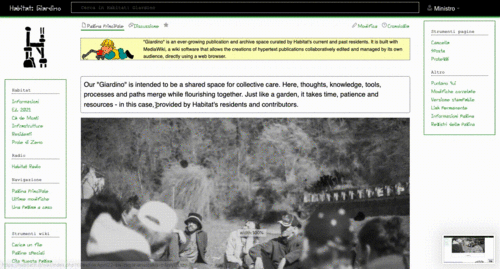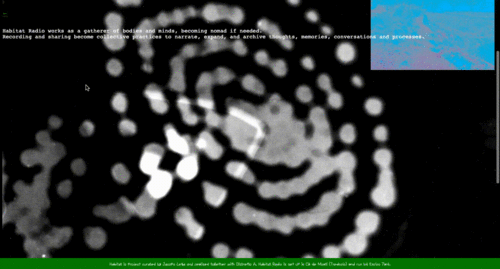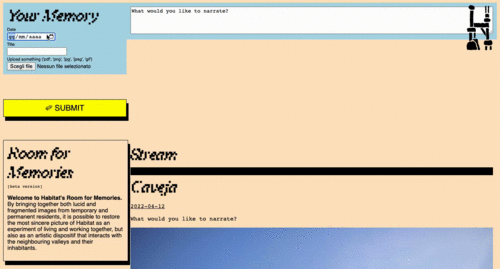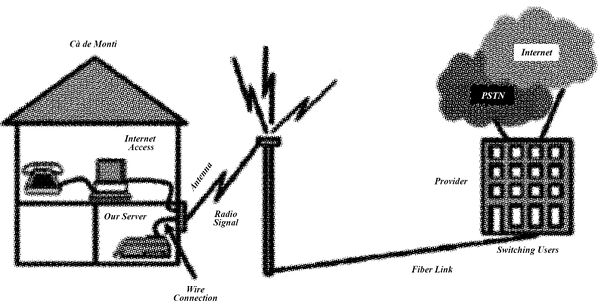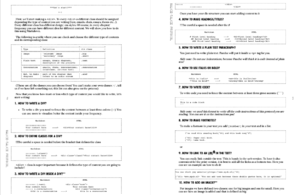User:Jacopo/final-presentation
- your individual contributions to the special issues,
- the development of your reading/writing practice across the 2 years,
- the development of your prototyping practice across the 2 years,
- your thesis (only a brief overview for context, as this has been assessed separately in depth),
- your final work and research in the second year,
- plans for final publication and grad show (with the understanding that you will continue to work on this after the assessment)
Roots
My previous academic career has been driving me inevitably to object-oriented design, aiming at solving specific issues. The tools we've been used to have been taken for granted till the beginning of XPUB. "Experimental publishing" was for me something traceable to punk-zine cultures. The Punk side popped up soon, and not only because of papers, scissors and stolen pictures, but mostly for the subversion of the idea of computer its related working tools. >>> There're instructions for anything you may need >>> You can build your own space, your own tools, and above all, open up processes toward a collective effort. While starting questioning tools and processes, my perspective expanded in the digital realm, which I could still relate to my beloved printed matter. This expansion includes now collective tools and practices, thanks to which become possible to address issues rather than contents, or objects.
Fancyness is cool, usefulness is cooler.
Year 1
Wor(l)ds for the Future
SPECIAL ISSUE 13
- Wor(l)ds for the Future collective page.
- Otherness, my individual contribution.
Facing Licensing for the first time. First time approaching re-publishing issues. How to preserve – expand – publish external resources/contributions? > Otherness by Daniel L. Everett.
Individual Contribution
Using black <input> form to delete nouns and places from the narration, and at the same time making the room for subjectivising the given essay.
1 person -> 1 interpretation of the reality ∞ people -> ∞ interpretations of the reality The reality is the cohexistence of all perspectives Otherness= individual1+individual2+.. = Oneness Embracing the Otherness
Embracing the Otherness means understanding our part in the given system of the world.
I created 3 web pages using Python. Pandoc has been used to translate markdown files into .HTML pages, but also to layout the printed version of the same pages.
- Demystifying HTML, .css
- Getting used to Python
- Web2print, Markdown, Pandoc
Woa!I didn't know I can make a printed publication out of a webpage!
Collective
Contextual Team + Design Team
I Don't Know Where We're Going, But..
SPECIAL ISSUE 14
I Don’t Know Where We’re Going But…"is a local networked city quest based in The Hague.
Playing with cities' elements and infrastructures.
The City as a Playground
The publishing process become a means for distributing (not-only) knowledge and the constitution of a public space of deliberation, where different points of social intersection could come across. Pleasure, intrigue and playfulness together in a "beautiful distribution" which embraces site-specificness as a method to re-approach the possibilities for sharing and assimilating contents.
Individual Contribution
The City Coloring Book is a small publication that plays around Dèrive, Psychogeography, getting lost in the urban jungle..and the fascination for vernacular graphic deisgn. I hidden the publications in a specific place - a small, shared neighborhood park where people could find only by solving a puzzle, printed in the Booklet.
Remixing Vernacular Graphic Design > Emphasizing the omnipresence of commercial propaganda > Dismantle it by shrink it into lines do be colorued.
I created an HTML pages that collect the city-framing process: https://hub.xpub.nl/sandbot/PrototypingTimes/HOTSPOTS/4%20shoppingstreet/city-framing/ I used Python Library OpenCV to re-work the individual frames taken from the original video.
- Python, Open CV.
On the other side, I started experimenting with Raspberry Pi and the Terminal.
- Warming up with Raspberry Pi
- Getting used to the Terminal
- Create a Local Area Network
- Making a server out of the Raspberry Pi
Contingent networks, immediate situations as spaces for publishing. The city shapes, influence, interact with the exhibition space.
Collective
- Worked with Martin on the identity of the Special Issue
- I designed, printed and hand-crafted with Nami and Euna the Booklet/Guide for the Launch Event @PNF, Den Haag
Radio Implicancies
SPECIAL ISSUE 15
Audio sources as a medium. The radio as a publishing platform. As soon as I learned how to build a web radio with Liquidsoap, I also decided to use it as a publishing tool for Habitat. I've always been busy with music-related events and content, but I never thought I could build myself an online platform for broadcasting.
- The radio as a physical, convivial space; able to gather people around its' environment
- The radio as an extended space (via WLAN)
- The Rituality: being together, communicating together
- Radio Implicancies Archive
Individual
- Building-up a web radio: Liquidsoap + Html
- Playing with PureData, SonicPi,
- Voices + Recordings
- Composing soundscapes for narrative-based broadcasts
- The voice as a medium
Collective
I designed and coded the Radio Implicancies Archive with Camilo.
Year 2
"Living itself exists in forms that must be questioned, rearranged, mobilized, and undone."
N. Thompson, Living as a Form, 2012
- Exploring current conditions of rural landscapes and decentralised villages.
- Resilience and Process of depopulation
- Dependence on main infrastructures and urban agglomerations
- Current and past Cultural assets, mainly rooted in agriculture, herding and self-sustainment
- Architectural, natural and human landscape - as fields for inspiration and action.
- How new cultural routes could enhance temporary, and eventually permanent settlements of new residents.
- Publishing within and beyond the local scale:
- Infrastructures and tools for an evolving cult-rural community
The infrastructures: What we used to take for granted. It is easier to notice their absence rather than their presence. Instead of questioning the technology itself, questioning how it is managed and who is made available for.
Habitat
- Building a resilient community
- The Infrastructures: Tools for the community (internal communication-exchange-share-contents gathering)
- Daily life involved in the publishing process <-> Publishing process involved in the daily life
The local context: source of inspiration and action.
Publishing in this context means knowing how to orient oneself in its map, gathering resources, interfacing with the community, and developing a sensibility for the site-specificness of a project - be it an artefact, a tool, a temporary exhibition or a workshop - which can and must relate to the social, cultural and architectural fabric of the place.
Thesis
The Diary as a Form. The way to restore the most sincere, yet subjective image of Habitat as a cultural operation, but also as an experiment of living and surviving, was through the narration of daily encounters, discoveries, and all the details that compose the Habitat ecosystem.
(People in residence, Local communities and villages, resources, spaces, the environment, infrastructures..)
Started as a personal diary, later developed as a digital tool to be provided to Habitats' residents as a possibility to narrate/archive/publish memories.
Final work and research
Habitat Server
Autonomous Archiving Practices. Embrace the local conditions of connectivity. Habitat Archive and webpages are hosted in a webserver donated by XPUB, eventually installed in Cà de Monti. Part of it's browsable in different online spaces:
Habitat Giardino
A collaborative, decentralised Archive made with MediaWiki
Our "Giardino" is intended to be a shared space for collective care. Here, thoughts, knowledge, tools, processes and paths merge while flourishing together.
Habitat Radio
Habitat Radio works as a gatherer of bodies and minds, becoming nomad if needed. Recording and sharing become collective practices to narrate, expand, and archive thoughts, memories, conversations and processes.
Room for Memories
[beta – soon in Habitat's server] Submitting (and not forgetting about) memories has never been that easy. This tool, developed with Flask, .HTML and .css, collects each <input> inside one .md file (per memory), which is returned in a stream of collective memories.
Habitat Pad
Open source online editor providing collaborative editing in real-time. It is installed in our server and provides to residents and collaborators a shared space for writing and exchanging material.
Activating the Archive trough the space
Me and Federico Poni (Minister of Infrastructure) will set up the Slash Gallery as an extension of the Habitat's archive, in which the digital files archived in our server (in Cà de Monti) are physically transposed or activated inside the exhibitions space (Slash Gallery)
Highlighting the connection established between Rotterdam and Tredozio, which makes possible access to our server from the exhibition space. (Worm↔connection↔Cà de Monti)
Elements:
- Habitat Radio Station (Broadcasting for 1–2hours, inclusive programme: everyone can jump in)
- PRINT! button – Emulate the "Random Page" in the Wiki. It prints a random page from Habitat Giardino.
> The radio programme for the day will depart from the randomly printed pages.
- The paper Igloo made with the printed papers from the Archive
- Screening: Habitat 2021 Documentary projected on printed elements from the Archive (like hanging clothes)
- Habitat Bookshelf – a selection of zines, publications and printed matter created over the last year by different temporary residents.
- Background Music in the space, playing recordings from Habitat's Veranda Studio
- Poster: Open Call 2022 – with the poster I'm publicly projecting the intentions of Habitat toward the next session of residencies, scheduled for September 2022
- Various Artefacts: The Sacred Harmor, the Javelin Antenna, the Pin-nic television (video from the I° Concerto), Low-tech/rural devices
Final publication
Collective
Protocol for a collective publication
With Camilo and Floor: creating a system that allows the compilation of the final publication by gathering materials directly from (Ether)pads, each one corresponding to a chapter/ frequency.
DESIGN AN OBJECT -> DESIGN THE PROCESS
- Markdown language to write the pads
- Pandoc to convert it to HTML using a python script.
- Paged.js will render the static website as a digital publication that can be printed.
[Taking care = Providing instructions to collectively build the publication] [Taking care = Sharing the process The instructions themself will be included as a part of publication
Individual Contribution
- A selection of memories from my diary, unfolding different manifestations of "taking care" around Habitat.
- A frequency written with Federico Poni, dedicated to the "shadow areas", in which high connectivity couldn't be performed or established at all; and why they should be preserved.
What to come?
On a personal layer: it's my life project. I want to grow here with Habitat, its flourishing community, the tools we create, the choral narration we reverberate through the valleys, and the spaces we dwell in with new meanings.
Recreating the ideal environment both for living and artistic practices, based on share and exchange. On Habitat's layer:
Begun as a temporary attempt to trigger the cultural landscape of Romagna toscana, Habitat became soon a shared action toward new, collective living forms. As soon as Habitat was established permanently in the village of Cà de Monti, since January 2022, it became an open, convivial place for hospitality, production, and research that has to be structured and developed, but also questioned and able to be re-shaped.
> an open platform for developing participative, cultural practices in the rural landscapes. > tooling the community. > cultural economies: redistributing funds to support research and production.

